Trap-Neuter-Return (TNR) Equipment and Supplies
Trap-Neuter-Return (TNR) is the humane and effective approach to community cat populations that improves cats’ lives and benefits every community. With the right equipment, anyone can do TNR in their neighborhood (we have a step-by-step guide at alleycat.org/TNRGuide).
On this page, you will find all the equipment you need for a smooth and successful TNR effort. Make sure you have these supplies on hand before you set out to trap.
TNR Equipment Checklist
- Humane box trap
- Drop trap
- Transfer cage
- Isolator (also called trap divider)
- Feral cat den (also called feral cat handler)
- Trap liner
- Trap cover
- Trap label
- Bait
- Floor liner
- Community Cat Colony Tracking System
- Alley Cat Allies’ educational materials
- Non-specialized items:
- Work gloves
- Spoon or fork
- Tape
- Reusable baggies
- Small food storage containers
- Paper towels
- Antibacterial wipes, gel, or spray
- First Aid Kit
- Bungee cords
- Zip ties or carabiners
- Pen or pencil
- Binoculars
- Camera
- Flashlight
- Drinking water and snacks for you
- Clothing appropriate for the weather and practical shoes
- Cleaning and disinfecting supplies
Humane Box Trap
A basic box trap is a painless and humane method of safely trapping cats. There are several sizes and models of box traps available, including kitten-size. Every experienced trapper has their own preference. Alley Cat Allies most often uses the following:
-
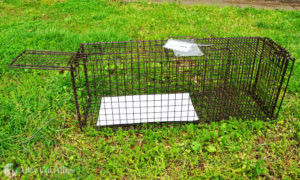
A set Tru Catch humane box trap.
Tru Catch Traps
www.trucatchtraps.com
Tru-Catch Trap/Manufacturing Systems, Inc.
300 Industrial St.
PO Box 816
Belle Fourche, SD 57717-0816
Phone: 800.247.6132 or 650.892.2717 -
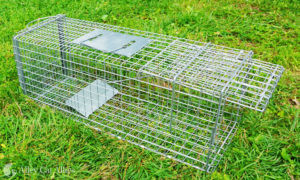
A set Tomahawk humane box trap.
Tomahawk Live Trap
www.livetrap.com
Tomahawk LiveTrap Co.
P.O. Box 155
Hazelhurst, Wisconsin 54531
Phone: 800.272.8727 or 715.453.3550
Fax: 715.453.432
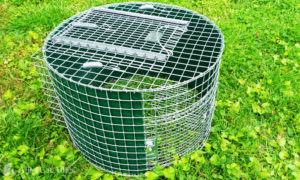
A Tomahawk Roundhouse Trap–a variation on the standard humane box trap.
Note: Listing these companies here does not in any way imply an endorsement by Alley Cat Allies, nor is Alley Cat Allies responsible for the content of the websites or the utility of the equipment.
When choosing a humane box trap, consider:
- Size. The standard size traps for community cats are usually referred to as the “cat” size. While kittens can be caught in cat-size traps, there are also “kitten” or “squirrel” sizes available that can help prevent injury. Trapping bigger cats, like tom cats, may require the larger “raccoon” size trap.
- Quantity. Make sure you have enough traps for all the cats you intend to trapone trap per cat plus a few extra just in case. If your goal is to trap 20 cats, then set about 25 traps on your first attempt. If you do not have access to that many traps at one time, you will have to trap the cats in shifts.
- Features. Humane box traps often have useful features for your success and safety, such as:
- Trip plate, which a cat steps on to trigger the trap to close.
- Back door which slides open so your hands can stay out of the trap and away from the cat.
- Handle which allows you to carry the trap with minimal contact.
- Borrowing traps. You may be able to borrow traps instead of purchasing them. Local TNR and rescue groups may loan traps to people in the area doing TNR. Reaching out to Alley Cat Allies’ Feral Friends Network® at alleycat.org/FeralFriends is a good place to start.
- Your local animal shelter or animal control agency may loan humane traps as well. However, make sure you know their policies regarding community cats and trap loaning before you borrow. While many animal shelters support local TNR efforts or have their own Shelter-Neuter-Return (SNR) programs, others may require you to return the trap and the cat to them. In some shelters, the cat may be killed.
IMPORTANT: Never use darts or tranquilizers to attempt to catch a cat. These methods are dangerous and can stress, harm, or even kill cats.
Drop Trap
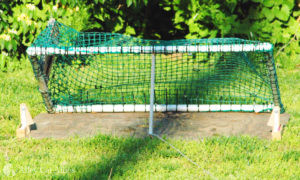
One of the many types of DIY drop traps.
Drop traps are useful for rescuing sick or injured cats or for trapping that one cat you haven’t yet managed to trap in a colony. Because drop traps are manually operated, you can spring the trap at just the right time and on just the right cat. Drop traps are helpful for trapping shy or savvy cats who are familiar with humane box traps and know how to avoid them, or even step around the trigger plate. You can find options at alleycat.org/DropTrap.
When choosing a drop trap, consider:
- Size. The trap should be big enough so when it falls, the cat is in no danger of it landing on her body. Large traps can be tough to transport, which is why some drop traps can be folded closed.
- Weight. The trap should be heavy enough that it doesn’t bounce and allow the cat to escape. It should also be light enough that if a part of it does accidentally touch a cat’s body while falling, no harm is done.
- Material. Drop traps can be made out of various materials, including wire, wood, and PVC. Each has its pros and cons.
- Transfer door. Drop traps should have a transfer door so a cat can be moved from the drop trap to a smaller trap or cage without having to lift the drop trap and risk the cat escaping.
Transfer Cage
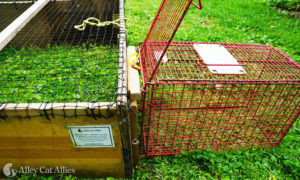
A transfer cage lined up to a drop trap’s transfer door.
Do not open a trap’s door or try to move a community cat with your hands. If you must put a cat in a different trap, cage or enclosure, use a transfer cage. The transfer cage’s door should line up with the door of the trap or enclosure the cat is already in without any gaps through which she can escape. The transfer cage’s door should slide up or to the side for easy opening. Remember to always conduct the transfer in a closed room, just in case.
Isolator (also called Trap Divider)
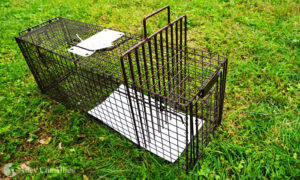
An isolator looks like a large pick or comb and is placed through the trap wires to keep a cat in a particular part of the trap.
This tool looks like a large pick or comb. The isolator is inserted into the top or side of a trap or cage to guide the cat into a small portion of the trap. This is important when you need to clean the trap while the cat is still in it, and for veterinarians to administer anesthesia before spay or neuter surgery. Using more than one comb can help you move the cat into the exact spot you need her and keep her in place.
Cat Den (also called Feral Cat Den or Handler)
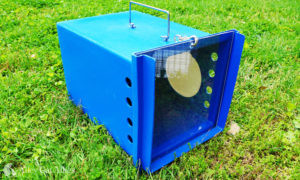
A cat den provides a quiet hiding place for a community cat.
If a community cat must be kept indoors for several days (for example, while recovering from an injury or extensive surgery), a den provides a quiet hiding place where she can feel safe. The cat den can be placed in a larger holding pen, cage, or crate along with a litter box, food, and water.
The cat enters the den by a porthole on the side, which you easily slide shut once the cat is inside. You can then take the cat out of the holding area for cleaning, treatment, or transportation. A vertical sliding door makes it easy to transfer the cat to another cage, move the cat to the larger holding pen, or return the cat to her outdoor home.
Trap Liner
A trap liner covers the bottom of a humane box trap. It disguises the trip plate, provides a place for the bait to sit, protects the cat’s paws, and makes clean up easier.
Some trap liner examples include:
- Folded newspaper. Taping the newspaper down to the trap can be helpful so it’s not moved by the wind.
- Vent covers. These covers are solid, thick, and resistant to tearing. They can also be magnetic, which helps them stay in place.
- Trap-specific liners. Trap suppliers often sell their own trap liners that fit specific models of their traps.
Trap Cover
A trap cover goes over the humane box trap to help keep a cat calm while they are in the trap. A trap cover must completely cover the trap and must be opaque so the cat can’t see through it. The darkness helps a cat feel safe.
Some examples of trap covers include:
- Large towels or small blankets. Most people have these on hand and they are easy to clean.
- Trap-specific covers. Trap suppliers often sell their own trap covers that fit specific models of their traps.
Trap Label or Tag
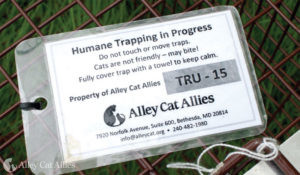
A trap tag or label provides key information.
These tags are important to identify that a trap is yours, and to inform community members on what the traps are being used for. That way, people are less likely to tamper with the trap or release a trapped cat. Make sure each trap has its own tag.
Alley Cat Allies has a trap tag template for you to use at alleycat.org/TrapTag. A trap label or tag should include:
- Your name
- Your phone number
- The trap number (ex, trap number 1 of 4)
- A note that humane trapping is in progress
- Warning not to touch the trap
- It’s helpful to laminate the label or tag so it’s resistant to weather and moisture.
Bait
Using the right bait in your humane trap is important! Bait should have a strong smell to attract cats and entice them to enter the trap. Some bait options include:
- Canned fish, such as tuna, sardines, mackerel, or anchovies packed in oil
- Jarred baby food (make sure it has no onions)
- Cooked chicken
- Canned cat food
- Catnip
- Valerian root. Boil the valerian root in water and douse the trap in the fragrant broth
Learn more about how to successfully bait a trap at alleycat.org/Bait.
Floor liner
It’s helpful to lay a floor liner when you plan to place cats in their traps on a surface you want to keep clean. To save yourself future cleanup, also spread liners in the vehicle you will use to transport the trapped cats to and from the trapping site and veterinary clinic. Floor liners can also be used in the recovery area where the cats in their traps stay after spay or neuter surgery.
Some floor liner options include:
- Puppy pads
- Cardboard
- Plastic bags
- Towels
- Sheets
Community Cat Colony Tracking System
Alley Cat Allies’ Community Cat Colony Tracking System is available to download and print at alleycat.org/Tracking.
This tool makes it simple to keep detailed information about each cat who is part of your TNR initiative. It includes space to record information about the colony location, the cats’ caregivers and trappers, and any involved veterinarians or clinics. It also tracks information for each cat including age, spay and neuter status, microchip ID number, and more.
Alley Cat Allies’ Educational Materials
Communication is the key to successful TNR. Alley Cat Allies’ educational materials will help you inform and educate your community members about community cats, how the TNR process works, and how TNR protects cats AND benefits the community. You can find a list of our educational materials at alleycat.org/Educate.
We also offer a convenient TNR Bundle and Coexisting with Cats Bundle in our shop for purchase or download.
Non-Specialized Items
In addition to the equipment specific to TNR above, your trapping kit would also benefit from some non-specialized items as well. It’s useful to have these items on hand before you start trapping:
- Work gloves to protect your hands as you carry traps
- Spoon or fork to help with baiting traps
- Tape to secure newspaper trap liners
- Reusable baggies and small food storage containers to organize your items and to store any leftover bait
- Paper towels to clean any messes
- Antibacterial wipes, gel, or spray to help keep your hands clean
- First Aid Kit for any minor injuries that might happen
- Bungee cords to secure traps together so they don’t shift during transport
- Zip-ties or carabiners to secure trap labels or tags
- Pen or pencil to write on trap labels or tags and Community Cat Colony Tracking System
- Binoculars to monitor set traps at a distance
- Flashlight to help you see during night or low-light trapping situations
- Camera to capture photos of each cat for the Community Cat Colony Tracking System. You can also photograph where traps are set and the surrounding area to help you return the cats to the exact trapping location
- Drinking water and snacks for you
- Appropriate weather-related clothing and practical shoes
- Cleaning and disinfecting supplies for traps once the cats have been returned

